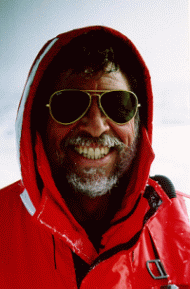
Bruce H. Robison

Bruce H. Robison
After earning a B.S. degree from Purdue University and an M.A. from the College of William and Mary, Bruce H. Robison returned home to California and to Stanford University, where he completed a Ph.D. program in 1973. He then spent two years conducting postdoctoral research on deep-sea fishes at the Woods Hole Oceanographic Institution in Massachusetts, before accepting a position at the University of California, Santa Barbara. In 1987 he joined the newly formed Monterey Bay Aquarium Research Institute (MBARI), where he served as Science Department Chair from 1991 to 1996, and where he is presently a Senior Scientist.
Robison's research interests are centered on the biology and ecology of deep sea animals, particularly those which inhabit the deep oceanic water column. He has pioneered in the use of undersea vehicles for these studies and he led the first team of scientists trained as submersible pilots for research in midwater. As a pilot or an observer, Robison has spent a good portion of his career in deep water, aboard more than a dozen different submersibles. At MBARI, his research team has focused on the development of remotely operated vehicles as research platforms for deep-sea research.
Dr. Robison's midwater research program is presently addressing the ecology of gelatinous animals in the deep sea. These enigmatic creatures play dominant roles in mesopelagic ecology, but they cannot be investigated adequately with traditional oceanographic methods. Related studies include ecological structure of midwater communities, physiology, and the behavior of midwater animals including fishes and squids. One element of the behavioral research asks how animals use bioluminescence in the deep sea, building on both laboratory and in situ observations.
Bruce Robison is a Fellow of the American Association for the Advancement of Science and a Fellow of the California Academy of Sciences. In 2002 he received the Marine Technology Society's Lockheed-Martin Award for Ocean Science and Engineering. He is a member of the Deep Submersible Pilots Association, and he chaired the Submersible Science Study Committee which provided long range planning for research submersible needs for the oceanographic community. His research in deep-sea ecology has carried him throughout the Pacific, into the Atlantic, and to the oceanic waters around Antarctica. Several of his projects have been conducted with colleagues from JAMSTEC (Japan Agency for Marine-Earth Science and Technology). He is the author of two books and more than seventy scientific publications.
Back to JSPS Home Page